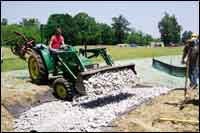Erosion control is nothing new for contractors and owners of construction projects. For more than a decade, sites five acres or larger have been covered by the National Pollutant Discharge Elimination System (NPDES) regulations, intended to protect the nation's water supply.
The U.S. Environmental Protection Agency cites storm-water runoff as the most common cause of polluting surface waters, and storm-water discharges from construction activities have a significant impact on water quality. Any time soil is disturbed on a jobsite—by excavation, grading during site preparation, or any other activity—there is a risk that storm-water runoff could carry pollution to surface waters.
Earlier this year, complying with NPDES requirements became more complicated. In March, Phase II NPDES regulations went into effect, greatly expanding the number of construction sites affected by NPDES requirements and making permitting more complex.
"Phase II literally means almost every construction site today needs to have a NPDES permit," says Shirley Morrow, CPESC, senior environmental scientist with engineering firm Burns & McDonnell, Kansas City, Mo. "Permits and agreements now are required on many projects where before they were unnecessary."
Phase II covers projects where land is to be disturbed on sites one acre and larger, requiring a project to have an erosion and sediment control plan; state NPDES permit; and a second local permit, if the site is in a jurisdiction with a population of 10,000 or more.
Understanding what is necessary to be in compliance with NPDES was never simple, in part because enforcement of Phase I was inconsistent or nonexistent. Phase II makes it even more difficult.
Federal NPDES regulations are guidelines for states to use in developing their own land-disturbance regulations; enforcement generally is delegated to individual states, says Morrow. Regulations vary greatly from state to state, and under Phase II, they may be different with cities in the same state.
"What you have to do to comply depends on where you are," says Morrow. "Permitting requirements are extremely variable throughout the United States and what they are in Missouri is not the same as in California or Pennsylvania."
To determine requirements for a specific project, Morrow advises checking with the appropriate state agency—usually the department responsible for regulating environmental quality. The next step is to determine whether Phase II regulations are in effect in the area where the project is located. Municipal permits most often are the responsibility of public works or utility departments. To further complicate local permitting, jurisdictions are not limited to municipalities—they include townships, counties, or any other concentration of people of 10,000 or more.
Yet many entities covered by Phase II have not yet defined permitting requirements.
"Phase II still is so new, not many ordinances are in place," says Morrow. "But it is better to find out before work begins, rather than learn of violations when an inspector comes to the job and asks why proper erosion and sediment controls are not in place.
"Phase II has made more people aware of the requirements," she says. "More cities and counties are putting programs together, there are many more inspectors checking projects, and more citizens are complaining, which results in more rigid inspections. Word is spreading that if you weren't obtaining the proper permits and preparing storm-water plans before, you'd better be doing it now."
Penalties for violations can range from a few hundred dollars to substantial amounts and an order to stop work.
Often there is confusion about who must obtain permits. Regulations state that the owner-operator is responsible for permitting, Morrow says. In that category are developers of residential and commercial developments. Public utilities usually obtain permits for water and sewer construction; electrical, natural gas, and telecommunications companies are responsible for permitting for their projects. Typically, erosion-control plans are developed by the project's consulting-engineering firm, which also handles permitting. Subcontractors may be required to be co-permittees, and in some areas contractor personnel may have to receive instruction about NPDES regulations before they can work on a NPDES-permitted project.
"On our projects, the owner gets the permits and we have contractors and subcontractors sign a form that they will abide with erosion-control provisions," Morrow says.
For more information: International Erosion Control Association (IECA), 970/879-3010, https://www.ieca.org offers training, and local chapters can provide localized information and expertise. Environmental Protection Agency, https://cfpub.epa.gov/npdes/.






